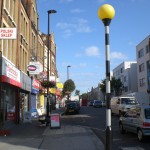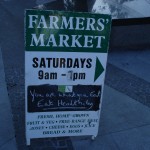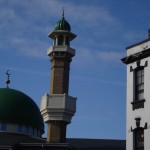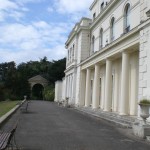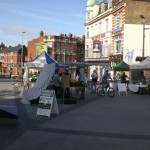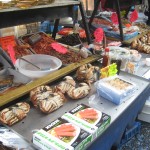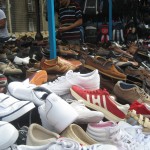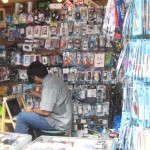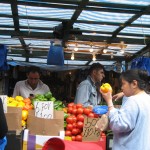Entries Tagged as 'Markets'
Whitechapel Market was in some ways exactly what we expected: predominantly Muslim and Hindu. There were Halal butchers, veils, saris and curry vendors on every corner. Most shoppers had tan complexions and wore Islamic or Hindu clothing; however, there were also white, black, and East-Asian shoppers. There were some ways in which Salaam, Brick Lane and our other readings about immigration to the East End didn’t prepare us, though: we saw a handful of authentic-looking English pubs when we expecting corner-to-corner curry joints; when we had anticipated a rowdy, bustling circus, the market seemed so empty that at first we weren’t sure we were in the right place. We walked up and down Whitechapel Road looking for a more likely candidate, resembling the market of Hall’s Chalky and Mr. Ali. We eventually realized we were in the right place, but since this is the holy month of Ramadan, the market is a little more subdued than usual. We also noticed the stall-keepers were almost entirely male, and that many of the mannequins had pale skin and light hair. Among our favorite experiences: meeting a lifelong Londoner on a park bench and learning about the “decline” of the East End; being continually surprised by the various cultural characteristics and quirks of the East End population; and arguing about headscarves and religious tradition on a Bethnal Green picnic table. Hope you enjoy our pictures of the Whitechapel Market and the surrounding area – we really enjoyed our experience there, and we can’t wait to go back and see it after Ramadan.
Here are some links we thought you might like to check out:
This one claims to be the definitive website on Ronnie and Reggie Kray. You may remember these two gangsters from Salaam, and sure enough, when we asked our elderly informant about what he considers to be the “real” East End, the Krays were the first thing he mentioned. If you’re looking for a better idea of what the East End used to be like (and what some residents wish the East End still was like), take a look here.
See an informational website regarding Ramadan here.
The Royal London Hospital is located on the other side of Whitechapel road. There is a link here for more information about the hospital.
[kml_flashembed movie="http://www.youtube.com/v/JMvSb8bVRQQ" width="425" height="350" wmode="transparent" /]
The video on YouTube
Tags: 2010 Amy · 2010 ChristopherB · 2010 MaryKate · Markets · Pubs · readings
[kml_flashembed movie="http://www.youtube.com/v/nZBtfNL7dP4" width="425" height="350" wmode="transparent" /]
Video on YouTube
After we got off the Tube at Covent Garden, we were a little disorientd so we asked a somewhat friendly-looking woman on the street for directions. In an eominous harbinger of our afternoon to come, she responded- in a dead flat American Midwestern accent- “Oh, I have no idea, it’s my first time here, too.” We soon realized the market was located just down the street. Within five minutes of entering, we found what the market was really about: a place for tourists and middle- and upper-middle-class locals to window shop and buy quasi-luxury items.
The first thing that surprised us about the market was the near total lack of ethnic food vendors. We actually only saw one food vendor, a fruit cart, despite the title Apple Market above the carts. Items for sale included handbags, jewelry, soaps, and other window shopping items. All of these were conspicuously advertised as “handmade,” creating a sense of authenticity for shoppers. Several of the vendors also sold paintings of the more traditional parts of London; items specifically for tourists. One vendor even had posters of American stars (i.e. Audrey Hepburn and Marilyn Monroe). These particular actresses are icons of higher class, which we felt reflected the classes that the market meant to attract. The area seemed to contain a lot of nouveaux rich items that would appeal to the middle- and upper-middle classes, as Fox suggests in Watching the English. The area seemed mostly designed for window shopping and watching free entertainment.
One of the entertainers, a melodramatic unicyclist, performed in front of St. Paul’s Church. There were two homeless men on the steps that most people seemed to be ignoring. The other historical area near the site was the Royal Opera House. To add to the artistic atmosphere, flags and various paintings hung along the market’s rafters.
We were surprised to find that most of the people in the area were white considering the amount of diversity in London. The people also seemed religiously neutral, compared to others we’ve seen elsewhere in London—we did not see any religious indicators, such as headscarves or yamoulkas.
The buzzword for the afternoon was definitely “homogeneity.” The market and its proprietors guarded the blandness of the place with extreme zeal. Ethnic restaurants (often chain restaurants) brandished flags with their countries of origin as if to make it obvious for tourists. A highlight of the unintentional comedy that this produced was a pub that hung a sign in the window saying: “Football colours are not permitted.”
The shops surrounding the market were equally lacking flavor. Many of the retailers were large American companies, such as: Oakley, Build-a-Bear, and Disney.
Amidst all this complaining about Covent Garden, it should be mentioned that the area felt extremely safe. We saw more young children in four hours today than we have seen in the fourty-eight hours we have been in London. The area was very family-friendly and also seemed to be a popular date spot for couples in their 30s and older. Also, the market was not totally soulless, as we had two fairly amusing encounters. First, we spotted a large group of men in rugby jerseys wearing obviously fake moustaches and Afro wigs. We felt compelled to ask them what drove them to do this, and the answer was that there was a rugby final at Wembley much later in the day. They came to the market to get drunk (although they seemed pretty well-behaved and claimed that they were neutral in support). Second, one of us gave in to the entreaties of a very haggard street salesman (wearing a lanyard with a card that said “WORKING, NOT BEGGING.” The card was not as unnecessary as it sounds) and bought a magazine from him. As he was clearly doing very poor business, we didn’t feel that bad chatting him up for ten minutes or so, a conversation dotted with some spectacular moments. The most memorable line was “You’re from the States then? You have Christmas, we have Christmas. But I have one big question: What the fuck is up with Thanksgiving? Seems like a bit of fraud to me.”
Tags: 2010 Dennis · 2010 Jesse · 2010 Mary · Markets
market video_0001
We spent the morning at Shepherd’s Bush Market in the area of Shepherd’s Bush, near Hammersmith. To get there, we took the Tube to Shepherd’s Bush station, a modern and pretty elegant-looking building. Once we were at the station, we actually had trouble finding the market. There were no obvious signs near the station, and the first person whom we asked had no idea what we were talking about. We took a wrong turn and wandered through a very new shopping and restaurant development in the same style as the station, but could not find the actual market. Someone did direct us, however, and we found the entrance.
When we entered the market, we readily realized why this place was little known. The Shepherd’s Bush Market is no more than a narrow strip of walking space, about the length of a city block and no wider than an average road, jammed with shops on either side. As we ventured into the market, inspecting the market’s goods and snapping photographs, we drew strange looks from shoppers there, who were invariably first generation immigrants, mostly from the Middle East. Popular items in the market were the necessities, food and clothing accounting for over half of the market’s goods. This suggests that, unlike other popular London market destinations, Shepherd’s Bush caters predominantly to the area’s immigrant community and their day to day shopping needs, rather than to tourists and day shoppers out for a bit of fun. Of the food shops in the market, halal butchers were the most prevalent. In immediate area surrounding Shepherd’s Bush Market, the same type of commerce thrived, with more halal butchers and restaurants and a few money exchange centers scattered about. Despite a heavy immigrant influence within the market, residential areas surrounding the area were largely native and seemed more affluent.
One aspect of the neighborhood that really struck us was the proximity of the local, immigrant-centered market with an enormous, modern shopping center. The Westfield Shopping Center, which opened in October 2008, is supposedly the largest shopping center in Europe. Inside we saw hundreds of people shopping at stores that ranged from Prada and Gucci to Nike and Adidas to H & M and other [slightly] more inexpensive stores. The mall was so big that there were several interactive map kiosks that would map out routes to certain stores for people. To read more about the mall, see Westfield’s website, http://uk.westfield.com/london/centre-information/about. Most of the shoppers here seemed to be white, probably native British. Both the shoppers and the elegant, silver architecture were a stark contrast to the colorful and cosmopolitan nature of the much smaller market. It seemed very strange that such a huge concentration of high-end stores was right in the middle of an area of so many immigrants. It did not match the streets around the market at all, but we noticed that there seemed to be more commercial development taking place on the other side of the mall.
Tags: 2010 Benjamin · 2010 Holly · 2010 Luke · Markets
[kml_flashembed movie="http://www.youtube.com/v/0_N3ivscSJg" width="425" height="350" wmode="transparent" /]Photo slideshow with narration: http://www.youtube.com/watch?v=0_N3ivscSJg
We travelled to the Market (located in the borough of Southwark) via the Tube’s northern line, which we exited at Kennington. From there, we proceeded to walk for about 10 minutes through residential neighborhoods until we arrived at the Market, the main entrance of which was announced by a large lettered gate.
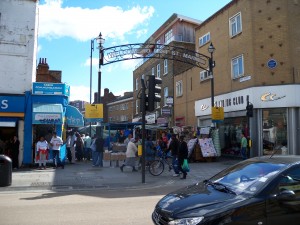
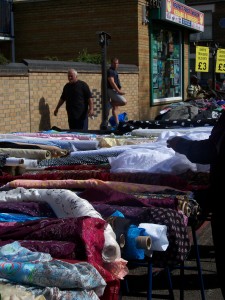
The Market, while not as large as many of the others London has to offer, was unique and vibrant. The majority of the goods were, somewhat unusually, clothing, shoes, accessories and textiles, as well as electronics, cosmetics, Cds & Dvds and other assorted items.
Many of the items were American-themed or American-style clothing or otherwise imported. The small amount of stalls with food were predominantly fruit and veg stands.
The vendors (and many of the customers- presumambly, the residents of the neighborhood) were typically either Jamaican/Afro-Caribbean, Middle Eastern or Eastern European, as well as a small number of Cockneys.
The vendors and customers engaged in an almost perpetual friendly sort of argument with each other: we overheard one conversation between an elderly Cockney vendor and his elderly female Cockney customer. After giving her his prices, he added “Tha’s cheap- betta than th’supermarket” and she replied snarkily “Tha’ ‘taint cheap- tha’s ‘spensive.” We didn’t experience much of the hassling that is typically found at marketplaces: we were pretty much left alone and didn’t hear
any creative vendor’s attempts to bring customers to their wares. However, on our way back were heard slightly more vocal advertisement and, on one memorable instance, a use of Cockney slang-insults to get attention: “1.50, hey, Lady wiff the mustache, over ‘ere!”
After we had covered the whole market (which stretched about 3 blocks) we explored the surrounding area which was mainly residential and consisted largely of low-income estate complexes (immediately recognizable through the tell-tale
sign of laundry lines across the balconies). Again, we mostly encountered people similar to the vendors of the market: largely immigrants or foreigners as well as lower class white Brits. While the neighborhood was relatively well maintained in terms of infrastructure, there were some physical signs of its standing as a lower class area: we found a telephone box with its windows smashed in and its inside completely covered in broken glass and cigarette stubs. In addition to this, many of the buildings were surrounded by barbed wire and a number of walls and fences were in a state of decrepitude. However, the area also contained some nice (but small) parks and at least two handsome churches. We were struck by several banners and posters put up by members of the community, protesting the borough council’s various planned developments to the area, some of which would encroach upon their parks. 
Speaking of religion . . . in the market, we found about 3 Christian bookstands, alongside many self-help books by American preachers. We also noticed a large Muslim population with many women wearing headscarves and other traditional garb. We detected a strong sense of community among the ethnic/religious groups: there were many hairdressers and stores catering exclusively to the Afro-Caribbean women as well as Jamaican DVD/Music stands for the men. There were multiple Halal butchers and restaurants as well as fishmongers.

All in all, the East Street Market and surrounding Southwark clearly exemplify a vibrant, diverse and community-oriented place.
Tags: 2010 Elizabeth · 2010 Patrick · 2010 Sean · Markets
August 22nd, 2009 · 1 Comment
We left the Arran House hotel at 8:30 AM to catch the Northern line on Goodge Street up towards the Central line. We eventually arrived at Shepherd’s Bush Station, and walked a few blocks to the market. Even though the market was technically open, many of the
stalls were closed and the walking path was deserted.
Hiding our frustrations we chose to explore the surrounding community. As we walked further on the main road, we observed the privately owned shops (most of which were closed), as well as the local pedestrians on the move. Despite the “not so upper class feel” of the main street, the residential side streets appeared cozy and well cared for. We were unable to conclude how the neighborhood would fit in the British class system.
Circling back to the market, we decided to take our first walk through, despite its emptiness. The market appeared to cater to those who needed essential items including produce, meat, clothing: Middle Eastern apparel and accessories, and household items. Half way through we met a nice policeman who inquired about our visit to the market. He told us the market would get busy around eleven after the local shopping mall opened.


We explored the parallel main street which was also lined with shops. As we walked by we realized the majority of stores catered to the Middle Eastern Community. There were many different textile stores (with Arabic store signs) in addition to a news stand full of Arabic newspapers.


After killing time in a local park (and patsy sitting on bird poop) we returned to the market at eleven to find it still. Regardless of its permanent state of death we decided to weave through the isles again. This time we noticed more established shops behind the vendors, including BEDAZZLED sneakers!

After numerous passes through, we agreed that the market would not pick up and so we left. Although this market did not live up to our expectations, each of us became more interested in exploring the other markets of London.
Happy Ramadan.
Tags: Chelsea · Flow · Markets · Patsy · Uncategorized
Students weren’t the only ones going to markets today. Lest I seem a heartless taskmaster, I set off on my own excursion. With the Victoria line closed today for engineering works (repairs) I took a circuitous route to Brixton. The first thing that struck me was the massive flight of Aussies and Brits from the Oval Tube station for the second day of the 6th test of the Ashes series. My idea of a great day is not sitting in the sun watching “athletes” in sweaters swing a small boat oar at a croquet ball. OK, I just don’t get cricket, but I’m trying. I continued down from the tube by bus to Brixton Market. What a wonder of beautiful color (both skin and fabrics). Brixton is traditionally known as an Afro-Carribean neighborhood, but I think most people would be surprised by the number of Halal butchers and green grocers from the Middle East. The calls of, “Yes, plaintains” with an Arabic accent accompanied the rhythm of reggae beats flowing from the music stalls. After wandering around a bit and running into some of my students next to Windrush Park I found a wonderful organic baker and purchased 1/4 loaves of mango bread and apple/plum/oat bread. After drooling over all the wonderful food I decided to take the first bus I saw and follow it anywhere it went. I ended up at Elephant and Castle (already known as “poop stop” to our group…see the earlier post). I walked from poop stop to Borough Market. What a juxtaposition (and you know I love my juxtapositions) to Brixton. Brixton as a handful of ethno-tourists, but otherwise it is all locals. Borough was nearly all white, seemingly wealthy, and numerous out-of-towners. Whereas Brixton had makeshift kiosks in the middle of lanes and small streets selling DVDs, CDs, cheap clothing and food, Borough Market has posh permanent stalls with overpriced produce, lattes, and gourmet items. Don’t get me wrong, the kangaroo burger I had for lunch was nice, but I should have gone with the jerk chicken. I continued onto to the Thames Walk through Clink, past the even more touristy Globe to Tate Modern (clean bathrooms!) and on to the National Theatre. Here I came full circle. Reggae Magic put on a great free concert as part of the NT’s “Watch tThis Space” series. Except now instead of the beautiful black skin, dreadlocks, and ubiquitous Jamaica shirts (remember, Usain Bolt just won two gold medals and set two world records) at the NT we had a nearly all white crowd that included two pitiful Elvis impersonators (one missing most of his teeth); a half dozen guys in green afro wigs, orange face paint, and white jump suits; and tourists, tourists, and more tourists. The music was fantastic and I found myself smiling for an hour straight. A walk over Hungerford Bridge to Embankment led me back to the hotel.
Such is the beauty of London. A lot of different peoples and places, and there is always something new to try. Music and food just happen to be my obsessions.
Tags: Markets · Professor Qualls
We departed the Arran Hotel at 8:20 and walked to Goodge Street Station. We took Northern Line to Leicester Square and arrived there at about 8:30 and then transfered to Piccadilly Line. After traveling through tunnels and above ground we arrived at Acton Town at 9:02. After studying the map we realized that we needed directions from a local. The first candidate that we spotted appeared normal but unfortunately she shunned us with a 10 Commandment display that hanged around her neck and simply said “No!” The next person we asked was a man who looked like he belonged in a “Just for Men” commercial due to the reddish tinge of his mustache which did not have any resemblance to his natural hair color. Despite his appearance he ended up being very helpful and gave us the proper directions.
After passing through what looked like a residential area we arrived at the market ten minutes later. We were a bit surprised by the lack of action taking place in the central market area. We walked up and down the market area observing each stand. We then had the pleasure of meeting Vanessa who was the market supervisor. Since we had our notebooks and cameras out she inquired as to whether we were reporters writing an article. We explained to her that we were college students exploring London markets and she notified us that many local residents are on a holiday and that it would be a quiet day at the market. Under the temptation of the delicious food scents wafting through the air we contemplated eating an early 10 AM lunch. While we were pondering, a curious old bloke with beer dripping down his chin told Henry that he was lucky to have two girls with him. After Henry nodded his head in agreement the man proceeded to ask us if we were from “down undah.” Sharing our heads profusely we articulated that we were in fact Americans. Immediately upon hearing this he rallied off a series of questions mentioning our change in government. After responding to his inquiries we got out of the market swiftly and decided to explore the surrounding area.
As we wandered up and down the nearby streets we noticed a growing Muslim population as evidenced by the new Mosque, the Library for Iranian Studies and multitude of restaurants that served Halal options. Part of the reason why the market place was empty was due to today being the first day of Ramadan. Acton struck us as a tight knit community that was not used to having people come and actively spend time within its town limits. That being said most everyone was friendly and greeted us with a smile. After scanning all the stands which included West Indian, free range sausages, fruit and vegetable stands, spit-roast BBQ, tapas, cheese and bread, and Afro-Caribbean cuisine we decided on South Asian. We indulged in chicken dishes, Aloo Katchori and black tea with milk. While we were eating we enjoyed Bob Marley tunes playing in the background.
Upon leaving Acton Market we decided it would be a good idea to make our way towards Gunnersbury Park to observe and absorb the sights and sounds of the day. As we ventured through the crumbling brick outer courtyard we came upon a large, white building that simply said “Museum.” We entered and began to explore the inside of the mansion that once belonged to a family in the Victorian Era. After exploring the extensive gardens we discovered Princess Amelia’s bathhouse, a greenhouse, and the remains of a turret. After wondering what life would be like as Princess Amelia we headed back to the Acton Town station and made our way back to the hotel. We arrived at the hotel at 13:15. We probably won’t make our way back to Acton Town. This was not because we disliked it but because it is not a type of place people would actively seek out.
Tags: Grace · Henry · Jeyla · Markets

As soon as you step off the bus at Brixton, the Caribbean and African influences in the community jump out at you. Signs for jerk chicken, racks of exotic spices, fresh melons and peppers, halal butchers, and the smell of fresh fish overtake your senses. The market extends for about two to three blocks and is full of colorful clothing, food, electronics, and toiletries. It was a bit intense of an experience to see fish so fresh they might still be wriggling, chickens hanging upside down with their heads still in tact, and butchers chopping animals up in the back of a market stand. That being said, many stands boasted products that could be purchased in any local or chain vendor. When asked where the jewelry she was selling was made, a vendor replied, “The factory”. In a similar vein, a different vendor was quite angry when we took a photograph of the DVDs he was selling- proof that they weren’t necessarily the most legal of all goods? Maybe. Still, as you strolled through the market, reggae music that was from other musicians than Bob Marley met your ears to show you that the market was more than just an outdoor equivalent to any old supermarket.



The racial aspect of Brixton was quite striking. The market vendors seemed to hail mostly from Jamaica, Ghana, and Nigeria. People from many different backgrounds crowded both the main street and the market. As soon as you step off the main road, however, you find yourself in a quiet, remote residential community mostly inhabited by white people. So as you journeyed through Brixton, the community seemed quite segregated. The majority of the residential area was white while the majority of those at the market were black. The street that connected these two areas was full of people of all races but the segregation was certainly noticeable. One circumstance made this segregation quite tangible to the three us today. One white man sat in the back of a quite crowded bus next to younger black men. For reasons unbeknownst to us, the black men started yelling and cursing at the white man. When he tried to leave the men, they grabbed his paper and increased the amount of profanity they threw his way. The bus then stopped and the three of us exited quickly to the market. The incident was not violent nor was it necessarily completely race related but it seemed to be if not characteristic than at least not out of place in terms of the tensions in the area.
On the edge of the market, a small plaque sat on the wall of a building. It commemorated those who were killed in a 1999 bombing of Brixton. As we had never before known of Brixton, hearing of a bombing took us by surprise. After researching the occurrence when we got back, we were able to make more sense of it. At the edge of Electric Avenue, a nail bomb was planted by David Copeland, a member of the British neo-Nazi Socialist Movement, in the early evening of April 17th. The group is a far right anti-immigration party. When the bomb exploded, it spit out glass and nails in a 20-foot radius and injured 50 people. He was planning on attacking other cities including Brick Lane and Old Compton Street (other racially and sexually diverse communities). Police accepted his testimony that he worked alone and he was sentenced to six life sentences in prison. This bombing is not an isolated incident in Brixton’s history. It is one example of racial tension that have persisted in the area for years. During the 1980s, the tensions erupted in multiple riots. These riots were usually sparked by the community’s distrust of authority and resulted in increased community damage and heightened tensions between the police and public. This tension continues today as we witnessed in the market. A vendor poked fun at a policeman passing by asking him, “Why aren’t you smiling? You never smile! You smile when you write a ticket though.” While the policeman continued walking by unfazed, the tension between community member and authority was still evident.

As you walk away from the market up a hill, you see a construction site for a proposed community center. Windrush Station will have representations from local community groups including the Black Cultural Archives and the Brixton Society. The name “Windrush Station” comes from the British ship Empire Windrush that brought the first generation of African Caribbean settlers to Britain to Brixton. The community hopes to hold events such as Brixton Splash that celebrate community pride of Brixton. Still, the website that advertises these events has pictures of only young white people who weren’t very prominent at the market that we saw today. So, while the community center promises to increase connectivity and inclusion in Brixton, it is not without the undertones of segregation.
*sidenote* We thought there might be a connection between Eddie Grant\’s \”Electric Avenue\” and Brixton’s Electric Avenue. Comments?
Tags: Audrey · Azul · Brandon · Markets





We arrived at the Camden Town markets around 9:30, after learning that the markets open around 10. In a matter of a half hour, we had found at least 4 different kinds of markets. The first one we explored was the Camden Market, a simple and small market with many snarky T-shirts and punk-rock items. All of us had expected this market to be like the markets you read about in books. Instead of the farmer’s market image with the stands of fresh fruits and vegetables, we were surprised to see many basic retail and punk-rock items. Only a few minutes there were needed. Across the street, was the Inverness Street Market which was smaller and consisted of the produce and tourist stands. However a quick turn put us at the base of the beautiful Camden Lock.
An enchanting bridge provided a pathway into the next part of the Camden market scene. These next three markets: Camden Lock, Interchange and Stable were connected with some indoor, some outdoor, and some both. Camden Lock and Interchange were outdoors and consisted of mostly food stands. Stable, our favorite, was a gigantic, mostly indoor market focusing on vintage clothing and antiques but with different vibes and from different cultures. We were surprised to observe that in the markets there was very little diversity amongst the shoppers. There were mostly white, British, young and middle-age shoppers, hardly any families or other ethnicities. The shops themselves though, were diverse in tastes and products from a Middle Eastern furniture store with beautiful chess sets to Cyberdog, a futuristic-themed clothing and accessory store. At one point there were also 6 restaurants in a row, ranging from Japanese, Indonesian, Mexican, BBQ, Indian, and Italian.
Since the tube stop was packed with people coming off, a quick turn onto a side street revealed a quieter neighborhood with few people about. This could mean that the patrons of these markets are not from Camden town and perhaps that many Londoners are drawn to it as a mecca of the trendy, funky, and diverse.
Having heard so much about Camden Town we were looking forward to spending the day browsing the markets. However, we found that 3 hours was sufficient to get the feel of the area and its visitors.
Tags: Aidan · Alli · Amanda · Markets
We took the Central Line from Goodge Station and switched onto the Waterloo line to Elephant and Castle at Charing Cross. As we moved farther down the line, we noticed that the number of business suits diminished and were replaced by more eccentric garb and hairstyles. After getting off at Elephant and Castle, we started to head in the right direction (towards Walworth Street) only to be re-routed (due to a “fatal accident” involving a bus) down a rather sketchy alleyway, only to make one giant loop and end up where we started. We wandered around, getting even more lost, and after consulting A-Zed, we finally got our bearings and headed down Walworth Street towards the East Street Market. Once there, we were bombarded with a rush of people, wares, sounds and smells. Reggaeton blasted from a CD and cassette tape booth, women in burkas sat under a tent draped with pashmina scarves and the aroma of bangers and burgers hung heavily in the air over the scene. Middle-Eastern and African vendors sold seafood and exotic fruits and vegetables arranged in wooden crates, and women loaded the produce into their bags, bartering with the vendors. There were booths selling watches, clothing (suits, dress shirts, slacks and lingerie), shoes, belts, toys, Christian books and movies, hats, sunglasses, jewelry, bags, scarves, cell phone accessories, linens and toiletry and cleaning products. But more interesting than the wares being sold was observing the interactions between those selling and buying. Vendors, for the most part, kept to themselves and did not call out to passersby. Some left their booths completely vacant and vulnerable to theft. One vendor in particular caught our attention. One of the few white British fruit vendors angrily accosted a potential buyer. As we were passing, we heard the vendor say to the man, “Speaking bloody f***ing English, you f***ing Bangladeshi.” The man walked away from the booth, and responded in very clear English, “English c**t.” We were shocked by witnessing obvious racial tension for the first time. It has become such a common scene in London to see people of all ethnicities sharing common spaces and interacting amicably with one another, and the altercation took us by surprise. Finally, we took the 176 to Tottenham Court Road and headed back home. While tensions do obviously exist in England, places such as East Street Market represent, for the most part, the harmony and co-existence between cultures which necessarily occurs every day in London.
Tags: Andrew F · Andrew R · Anya · Markets










